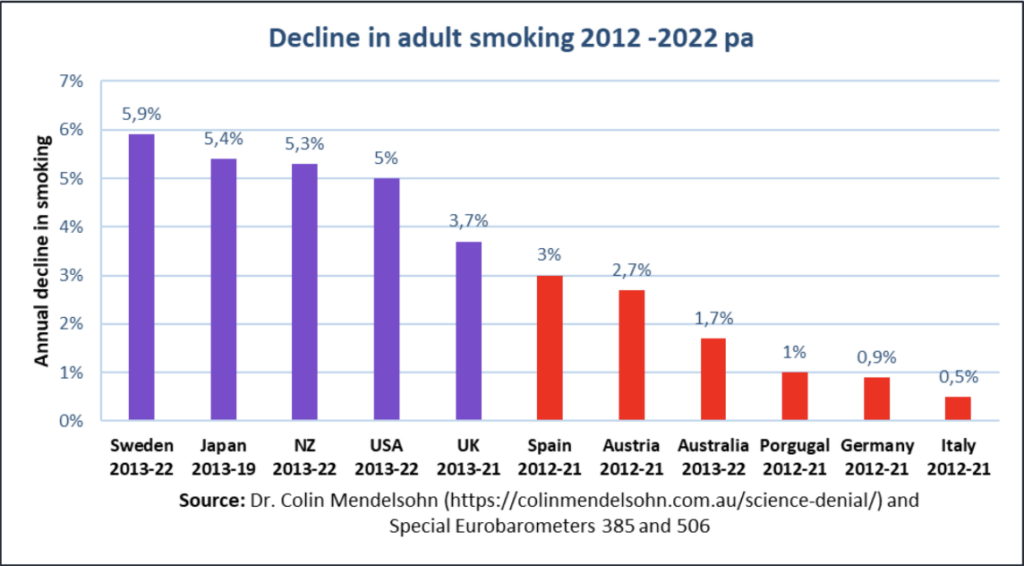CASE STUDIES
Learning from the Best
Countries like the United Kingdom and Sweden serve as compelling examples, demonstrating that a more permissive stance towards alternative nicotine products can lead to a significant reduction in smoking rates. Achieving smoke-free objectives becomes attainable when governments take cues from the most successful and efficient approaches. Nations that have embraced alternative nicotine products such as vaping, heated tobacco, nicotine pouches, and snus have generally witnessed a swifter decline in smoking rates compared to their counterparts. It is high time for countries worldwide to glean valuable insights from these leaders in tobacco harm reduction.
Here are five global lessons every country should adopt to become a tobacco harm reduction champion:

The United Kingdom has become a global leader in promoting vaping as a harm reduction tool. The UK government and public health institutions fully endorse vaping as a safer alternative to smoking, actively encouraging smokers to make the switch. Over the past decade, smoking rates in the UK have plummeted by more than 29%, coinciding with the rise of vaping. Compared to the EU, smoking rates in the UK have fallen twice as fast. As of today, only 12% of the British population are current smokers, compared to 23% in Italy, 24% in Germany, and 28% in France.
Key facts:
- Vaping is recognized as 95% less harmful than smoking by over 100 governmental and non-governmental organizations.
- Vaping is a highly effective tool for smoking cessation, with twice the success rate of nicotine replacement therapies (NRTs).
- The embrace of vaping helped the UK to reduce smoking rates faster than countries opposing vaping.

The use of snus has surpassed the smoking of combustible cigarettes in Sweden. Sweden is on track to becoming the first country to reach the smoke-free goal, with a current smoking rate of 5.6%. Despite a similar overall nicotine consumption rate compared to other European nations, Sweden exhibits significantly lower smoking-related mortality rates.
Key facts:
- Snus is markedly less harmful than smoking and serves as a helpful smoking cessation aid
- Sweden is becoming the first country to achieve the smoke-free goal of a 5% smoking rate.
- Public health improved in Sweden due to the transition from smoking to snus.

Nicotine pouches are the newest smoking alternative and, therefore, not yet adequately regulated in many countries. Currently, they are either unregulated, entirely banned or treated the same as cigarettes in most countries — and none of these alternatives are optimal. With consumer-friendly regulation, nicotine pouches could play a pivotal role in advancing smoke-free objectives.
Key facts:
- Nicotine pouches are the least harmful nicotine alternative to smoking and have a similar risk profile as conventional nicotine replacement products (e.g. gums or patches).
- At the same time, they serve as a smoking cessation tool.
- Nicotine pouches have enormous potential to reduce smoking-related deaths.

Over a mere five-year period (2016-2021), cigarette sales in Japan plummeted by 43% due to the introduction of HnB products. More and more people in Japan are rejecting cigarettes and choosing less harmful alternative products such as heat-not-burn. The HnB rate in Japan is currently at about 4.5%, and the Health and Nutrition Survey found that 76% of HnB users were no longer smoking cigarettes.
Key facts:
- There’s evidence supporting that HnB products are less harmful than smoking. Studies reveal lower levels of harmful chemicals in their vapor compared to cigarette smoke.
- HnB expose users and bystanders to toxicants at substantially lower levels than cigarettes.

